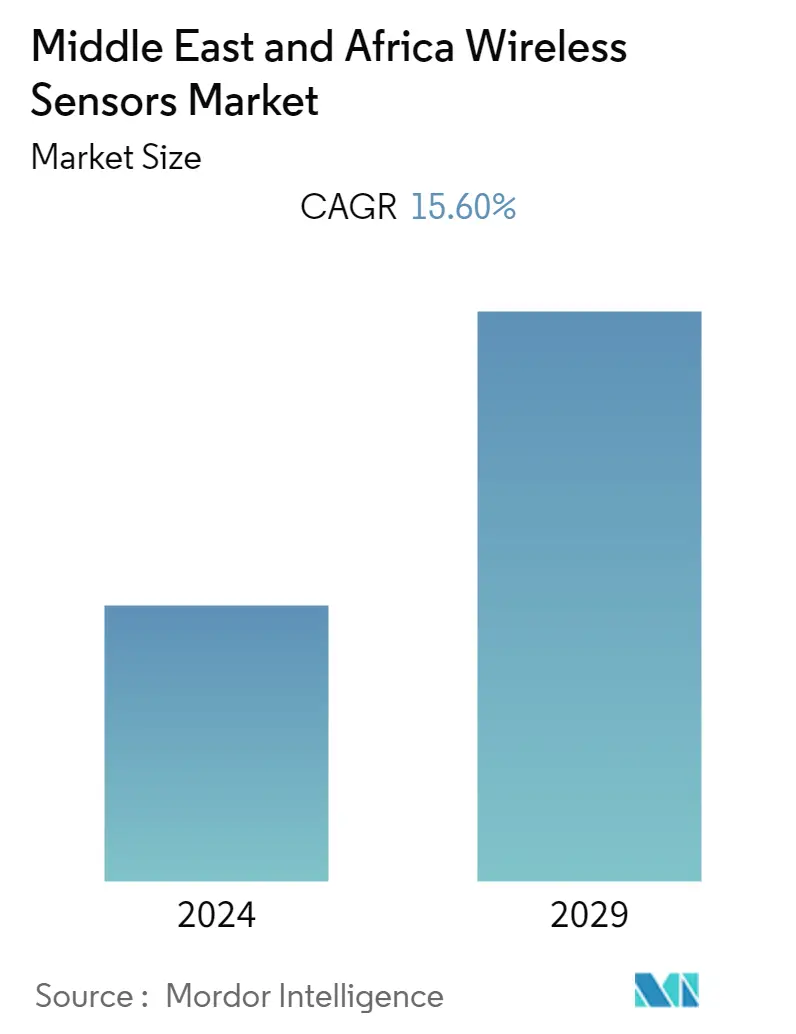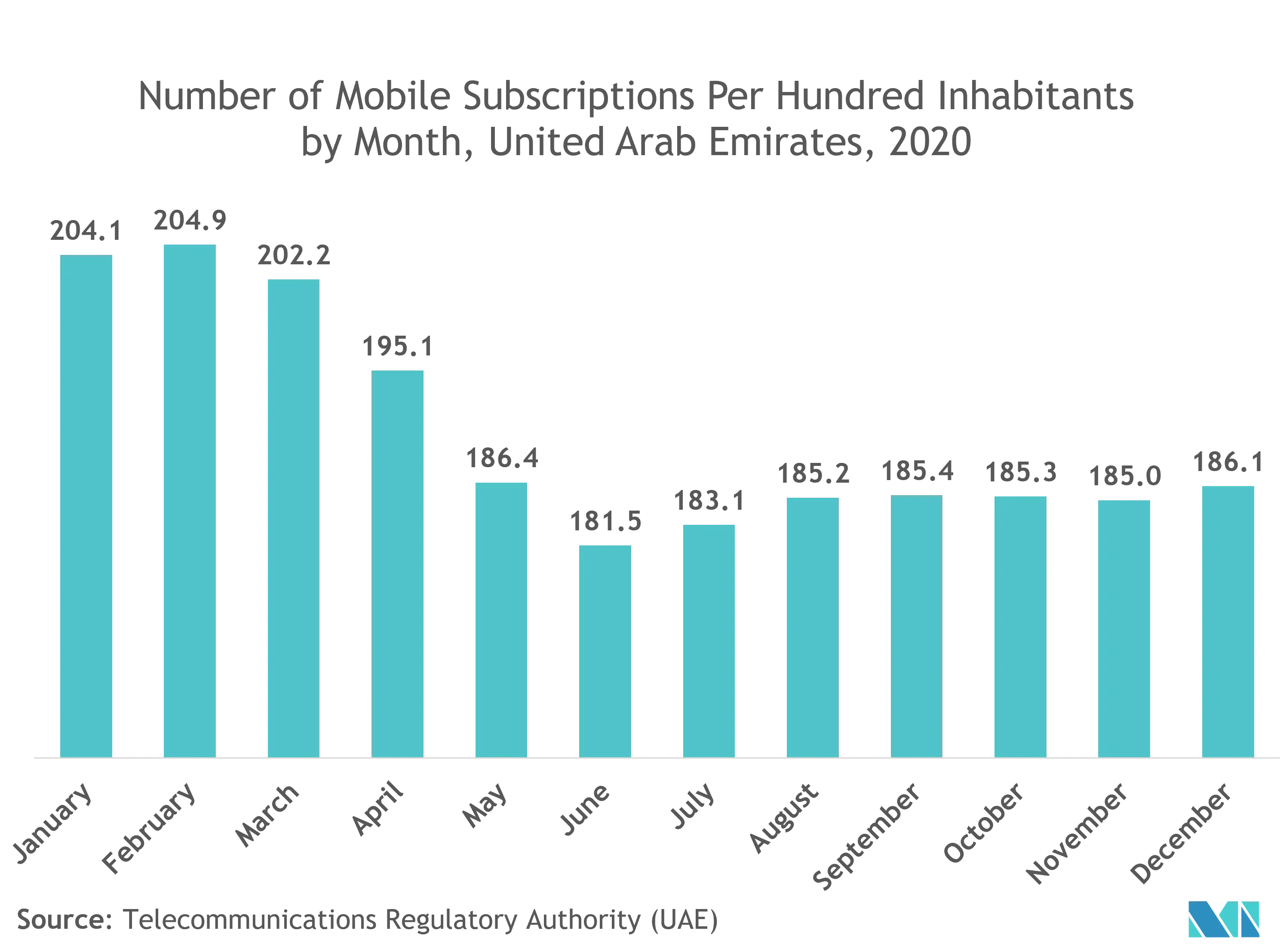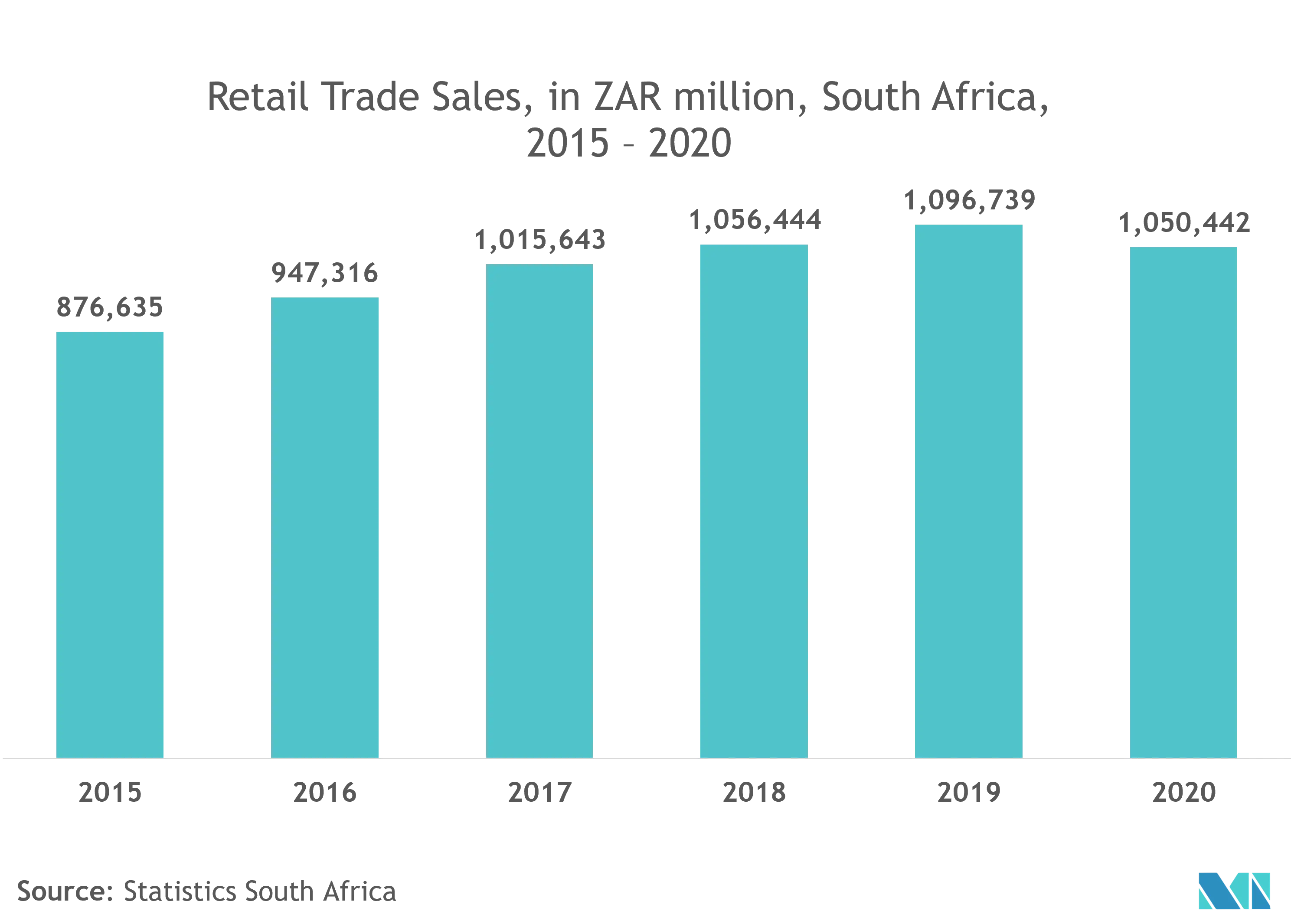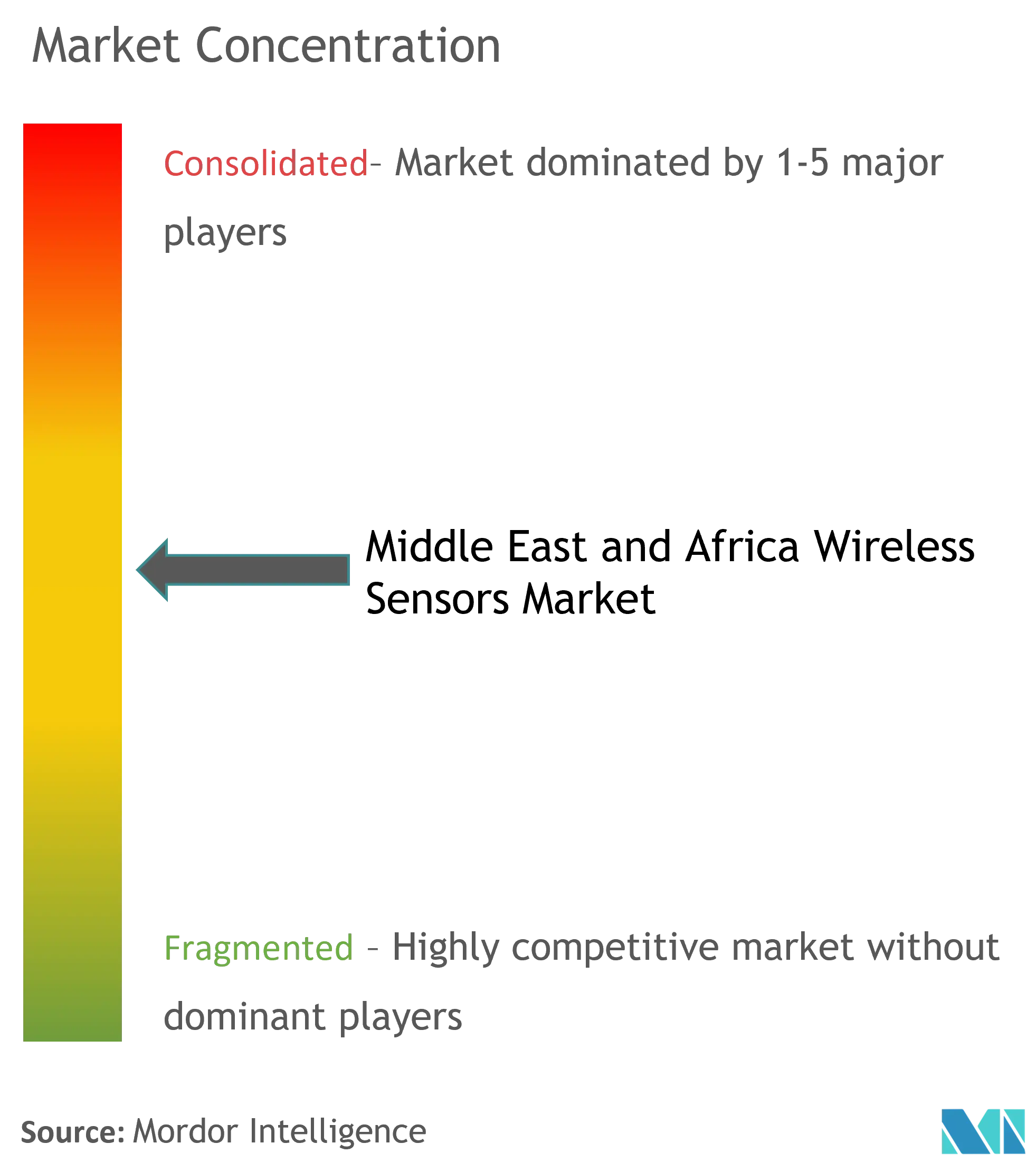MEA Sensors Market Size

| Study Period | 2019 - 2029 |
| Base Year For Estimation | 2023 |
| Forecast Data Period | 2024 - 2029 |
| Historical Data Period | 2019 - 2022 |
| CAGR | 15.60 % |
| Market Concentration | Medium |
Major Players
*Disclaimer: Major Players sorted in no particular order |
MEA Sensors Market Analysis
The Middle East and African wireless sensor market are expected to register a CAGR of 15.6% during the forecast period (2021 - 2026). The growth in Industry 4.0 with the COVID-19 pandemic on the global scale has been acting as a catalyst that pushed the development of intelligent wireless sensors that help improve energy consumption with a high level of efficiency in the region. The growing range of pressure applications in industries contributes to developing single devices that can handle a range of pressures. Such devices are set to simplify product designs, accelerate time to market and reduce sensory inventory costs of industrial manufacturers.
- Africa is undergoing a technology boom, owing to the government's emphasis on telecommunications and the Chinese investment in the region, especially in emerging technologies. With the region's economy expected to be driven by South Africa, Kenya, and Morocco, consumer spending is also expected to increase further.
- Automotive and healthcare production substantiates the region's demand for wireless sensors. The area lacks the local production of aerospace and military equipment and other industrial control systems.
- According to Federal Ministry for Economic Affairs and Energy, around 1 million sensors are estimated to be the total demand for the Middle East region. Although there are no significant wireless sensor manufacturers in the region, such statistics indicate the scope for global manufacturers.
- The increasing military spending across the Middle East paves the way for technologies like drones/unmanned aerial vehicles (UAVs). In addition, the usage of wireless sensors in traditional fighter jets with high-end navigation systems is increasing significantly. The factors mentioned above are creating an exponential demand for wireless sensors in volumes as well.
- Additionally, the healthcare sector has witnessed a rise in wireless sensors, as these are helping care teams monitor patients in real-time. Wireless pushbuttons are serving as PERS devices in different senior care facilities. Humidity sensors are helping hospital facility managers to maintain healthy environmental conditions for patients.
- Moreover, wireless networks have many advantages, as they are easy to add or even easy to modify. If the room function or layout changes, it is possible to quickly reposition these sensors to get a stronger signal. For instance, they can be used for a modular retail or office space, with partition walls that change depending on use, or a temporary installation in a rented building.
MEA Sensors Market Trends
This section covers the major market trends shaping the MEA Sensors Market according to our research experts:
Position and proximity sensor is Expected to Hold Significant Market Share
- Position sensors can detect an object's movement or calculate its relative position relative to a known reference point. Sensors of this type can also be used to detect the presence or absence of an object. Many sensor types perform similar functions to position sensors that are worth mentioning. Motion sensors detect an object's movement and can be utilized to initiate an action. Proximity sensors can also identify when an object enters the sensor's range. As a result, both sensors could be classified as specialized position sensors.
- Position sensors are made/assembled with various components from several vendors, including position magnets, sensing rods, electronics housing fixtures, diagnostic light-emitting diodes (LEDs), and connectors. Profitability is primarily determined by the availability and cost of raw materials and components, as well as the length of time it takes to bring the finished product to market. The main challenge for enterprises in this area is expanding their manufacturing capabilities, producing higher-quality products, and lowering overall production costs.
- Wireless device Proximity sensors are switches or sensing devices that can detect a nearby, specific object without touching it physically. All of them, in most cases, necessitate proximity to the thing being detected (approximately 12 inches or less). Proximity sensors are low-maintenance and robust to a variety of pollutants and environmental conditions. Certain proximity switches can be made to work in severe environments, such as those involving corrosive or dangerous chemicals, as well as intense heat and cold.
- Proximity sensors detect the distance between a target (the object being measured) and the sensor without physical contact. Inductive proximity sensors, magnetic proximity sensors, capacitive proximity sensors, photoelectric proximity sensors, and ultrasonic proximity sensors are just a few examples. They're used in various applications, including autonomous vehicles, smartphones, planes, smart factories, etc.
- Further, using a wireless sensor network in military applications like tracking enemy movements and force protection is standard. Due to the unattended nature, low memory, and limited network power, security is a big problem and complicated to achieve. Position sensors can monitor moving surfaces like a Boeing 777's flap skew, a fighter jet's exhaust nozzle, and an aircraft's hydraulic reservoir.

South Africa is Expected to Account For Significant Market Share
- The manufacturing industry in South Africa is growing significantly. It remains one of the key contributors to GDP growth and direct employment. This has also increased the adoption rate of automation in the South African manufacturing industry, hence driving the market for wireless sensors in the region over the forecast period.
- The growth of the wireless sensors market is driven by the application in the various end-user industries. Manufacturers invest in R&D activities to improve the accuracy and reliability of wireless sensors. Wireless sensors are used for data monitoring and other similar functions and in building automation, military and defense, and other industries, like food and beverage and material handling.
- Food and beverage manufacturers increasingly depend upon automated controls to achieve higher consistency and quality. This, in turn, has fueled the demand for wireless sensors. The need to maintain plants' ideal temperature and humidity levels to manufacture various food items, such as bread, has led to the broader use of wireless sensors in South Africa.
- Moreover, the retail industry's rising demand for wireless sensors is fueling the growth of the market studied. Retail users use a wireless sensor network to ensure hygienic production, storage, and distribution of their products. A recent application in a bakery used a wireless network to monitor gas consumption in ovens.
- Further, the country's Internet of Things (IoT) solutions market is significantly growing, driven by solid growth in southern and northern African regions. Both consumer and business IoT solutions offer promising opportunities in the area, which will give the African wireless sensors market competitive advantage.

MEA Sensors Industry Overview
The Middle East and African wireless sensor are highly competitive owing to multiple vendors providing wireless sensors to the domestic and international markets. The market appears to be moderately fragmented, and the major players with a prominent share in the market are focusing on expanding their customer base across international countries. Additionally, these companies are continuously innovating their products to increase their market share and increase their profitability. Some of the recent developments in the market are:
- March 2021 - Monnit Corporation announced the availability of its ALTA Soil Moisture Sensor to meet the AgriTech market's demands. The innovative Soil Moisture Sensor assists farmers, commercial growers, and greenhouse managers in easily connecting their precision irrigation operations to the Internet of Things (IoT).
- January 2021 - Everactive, a technology company that builds the Internet of Things (IoT) solutions, raised USD 35 million in funding to develop its battery-free wireless sensors. The funds will be used to accelerate sales, marketing, and product development of the company's battery-free wireless sensors for industrial applications. Moreover, Everactive's end-to-end monitoring solutions are aimed at high-volume industrial assets that are currently unmonitored or under-monitored due to sheer volume.
MEA Sensors Market Leaders
-
Honeywell International Inc.
-
Emerson Electric Co.
-
Texas Instruments Inc.
-
ABB Ltd.
-
Pasco Scientific
*Disclaimer: Major Players sorted in no particular order

MEA Sensors Market News
- January 2021 - Swift Sensors, a provider of industrial IoT sensor solutions, announced the launch of its secure wireless vaccine storage unit monitoring and alert system to enable medical facilities and pharmacies to monitor COVID-19 vaccine storage temperatures remotely, automate data logging, and respond quickly in case of an equipment problem or power failure.
- June 2020 - ABB announced a wireless condition monitoring solution for rotating equipment on an industrial scale. The use of wireless sensors reduces the expense and complexity of sensor installation, wiring, and connection. Customers with large sites, such as automotive manufacturing plants, processing plants, or airport baggage handling systems, can now collect valuable health and performance data from rotating equipment using ABB ability smart sensor technology and Aruba Wi-Fi infrastructure.
MEA Sensors Market Report - Table of Contents
1. INTRODUCTION
- 1.1 Study Assumptions and Market Definition
- 1.2 Scope of the Study
2. RESEARCH METHODOLOGY
3. EXECUTIVE SUMMARY
4. MARKET INSIGHTS
- 4.1 Market Overview
- 4.2 Industry Value Chain Analysis
-
4.3 Industry Attractiveness - Porter's Five Forces Analysis
- 4.3.1 Bargaining Power of Suppliers
- 4.3.2 Bargaining Power of Consumers
- 4.3.3 Threat of New Entrants
- 4.3.4 Threat of Substitutes
- 4.3.5 Intensity of Competitive Rivalry
- 4.4 Technology Snapshot
- 4.5 Assessment of the Impact of COVID-19 on the market
5. MARKET DYNAMICS
-
5.1 Market Drivers
- 5.1.1 Increasing Adoption of Wireless Technologies (Especially in Harsh Environments)
- 5.1.2 Emergence of Smart Factory Concepts (Industrial Automation)
-
5.2 Market Challenges
- 5.2.1 Higher Security Needs and Cost associated with the Sensor Products
- 5.2.2 Concerns pertaining to cybersecurity in the IoT space and recent developments
6. MARKET SEGMENTATION
-
6.1 By Type
- 6.1.1 Pressure Sensor
- 6.1.2 Temperature Sensor
- 6.1.3 Chemical and Gas Sensor
- 6.1.4 Position and Proximity Sensor
- 6.1.5 Other Types
-
6.2 By End-user Industry
- 6.2.1 Automotive
- 6.2.2 Healthcare
- 6.2.3 Aerospace and Defense
- 6.2.4 Energy and Power
- 6.2.5 Food and Beverage
- 6.2.6 Other End-user Industries
-
6.3 By Country
- 6.3.1 Saudi Arabia
- 6.3.2 United Arab Emirates (UAE)
- 6.3.3 Africa (Nigeria, Kenya, Ghana)
- 6.3.4 South Africa
- 6.3.5 Rest of Middle East and Africa (Qatar, Bahrain, among others)
7. COMPETITIVE LANDSCAPE
-
7.1 Company Profiles
- 7.1.1 Honeywell International Inc.
- 7.1.2 Emerson Electric Co.
- 7.1.3 Texas Instruments Incorporated
- 7.1.4 ABB Ltd.
- 7.1.5 Pasco Scientific
- 7.1.6 Schneider Electric
- 7.1.7 Siemens AG
- 7.1.8 Monnit Corporation
- 7.1.9 Phoenix Sensors LLC
- *List Not Exhaustive
8. INVESTMENT ANALYSIS
9. FUTURE OUTLOOK OF THE MARKET
** Subject To AvailablityMEA Sensors Industry Segmentation
The study characterizes the wireless sensors market based on the type of wireless sensors, the end-user industry, and the country. Wireless sensors are measurement tools for monitoring and recording the physical conditions of the environment. They are equipped with transmitters that convert signals from process control instruments into a radio transmission. These sensors have various applications in numerous sectors, such as automotive, healthcare, aerospace, etc. These have formed the part of the study in considering the end-user industry estimation. The scope of the study is currently focused on key regions, such as Saudi Arabia, United Arab Emirates, South Africa, etc. Further, to arrive at the overall market projections, the study analyzes the impact of COVID-19 and the investment scenario and other macro-economic factors.
| By Type | Pressure Sensor |
| Temperature Sensor | |
| Chemical and Gas Sensor | |
| Position and Proximity Sensor | |
| Other Types | |
| By End-user Industry | Automotive |
| Healthcare | |
| Aerospace and Defense | |
| Energy and Power | |
| Food and Beverage | |
| Other End-user Industries | |
| By Country | Saudi Arabia |
| United Arab Emirates (UAE) | |
| Africa (Nigeria, Kenya, Ghana) | |
| South Africa | |
| Rest of Middle East and Africa (Qatar, Bahrain, among others) |
MEA Sensors Market Research FAQs
What is the current Middle East and Africa Wireless Sensors Market size?
The Middle East and Africa Wireless Sensors Market is projected to register a CAGR of 15.60% during the forecast period (2024-2029)
Who are the key players in Middle East and Africa Wireless Sensors Market?
Honeywell International Inc., Emerson Electric Co., Texas Instruments Inc., ABB Ltd. and Pasco Scientific are the major companies operating in the Middle East and Africa Wireless Sensors Market.
What years does this Middle East and Africa Wireless Sensors Market cover?
The report covers the Middle East and Africa Wireless Sensors Market historical market size for years: 2019, 2020, 2021, 2022 and 2023. The report also forecasts the Middle East and Africa Wireless Sensors Market size for years: 2024, 2025, 2026, 2027, 2028 and 2029.
Middle East and Africa Wireless Sensors Industry Report
Statistics for the 2024 Middle East and Africa Wireless Sensors market share, size and revenue growth rate, created by Mordor Intelligence™ Industry Reports. Middle East and Africa Wireless Sensors analysis includes a market forecast outlook to 2029 and historical overview. Get a sample of this industry analysis as a free report PDF download.



